You can have fun teaching your dog simple tricks. And you can amaze your neighbors and friends.
Everything I teach uses a conditioned reinforcer -- a marker that tells the dog, "You're right!" To teach a conditioned reinforcer, select a marker word (one you don't use in ordinary conversation like "yay" or "YESS!"), use a clicker, or simply a tongue cluck. A lid from a Snapple bottle works, as would a ball-point pen clicking on and off. To teach the dog that the marker means food is coming, sit in a quiet place with a handful of dog treats. Make the sound and then feed immediately. Do this about 10 times. Then ask for a behavior the dog knows how to do, such as sit. Command "sit" and then mark the behavior with your special sound and feed. To be effective, you must feed every time you use the mark.
It is important to be patient in teaching any new behavior If your dog isn't doing what you want it to do, give the dog time to learn. If you become frustrated, stop training. Make your training sessions fun -- for both you and your dog. Most dogs can be taught most of the tricks described here. Few dogs will be able to learn all of the tricks. The easiest tricks to teach are those that take advantage of a natural behavior of the dog. Dogs that like to bark can be taught to "speak" easily; dogs that naturally extend their paws can be easily taught to "shake hands." Some dogs have good balance and can "sit up." Others lack this balance and can never do this trick no matter how hard they try.
Know your own dog -- work with it and give it a chance to learn. If the dog doesn't catch on at first, keep trying. If your dog can't do something, even though it tries, give up and move on to something else.
Here are some tricks you and your dog might enjoy:
Shake hands
With your dog sitting, reach down and take hold of its right paw
with your right hand and lift the paw gently. Tell your dog
"Shake!" as you do it. Lift the paw until it is on the level of the
dog's chest and then shake it gently just as though you were
shaking hands. Praise. Repeat six times a day for a few days, then
just try reaching out for the paw, but don't take it. If the dog
lifts its paw, take it and shake it gently, praising. Keep up the
praise.
You can encourage this behavior by holding a treat tightly cupped in your hand. Some dogs will paw at your hand. Mark the behavior and reward. Or put a piece of tape on the bottom of your dog's foot -- the dog will probably lift a paw to get rid of the tape. Mark the behavior as dog lifts a paw.
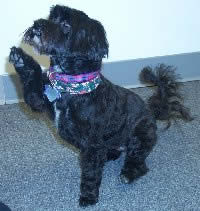 Wave
Wave
This is a variation of "shake hands." Wave at the dog -- be sure to
use a signal that is unlike any that you use in obedience or other
activities. At the same time, tell the dog, "wave." You can
encourage this behavior by gently touching the dog's paw with your
right hand as you wave with your left and say, "wave."
Roll over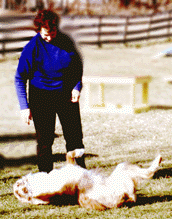
Make learning this trick a game. Get down on the floor with your
dog and wait until it is lying on its side. Put one hand in the
middle of its back, your other hand under its chest and shoulders.
Tell your dog "Roll over!" and turn it gently over as you do so.
When it is over, praise. Do this three or four times a day. Once
the dog gets the idea, cut down on your assistance until the dog is
doing it on its own. Keep up the praise. An alternative method is
to lure the dog over by using food held just about an inch from its
nose. Once the dog is over, give the food reward.
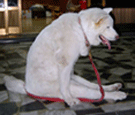 Sit up
Sit up
Sitting up is an entirely unnatural position for a dog, so it will
have to be helped at first (a few dogs can never do this). To
start, sit it in a corner, facing out. Tell your dog "Sit up!" and
lift it gently with your hand on dog's chest until dog is in an
erect sitting position. Keep it there a few moments, then put one
finger under dog's chin to help your dog keep its balance. Repeat
the command, hold the dog there for a few seconds, then let it
down. Praise. Repeat this six times a day until the dog will stay
without your help once you have got it up. Then keep working on
this trick until the dog goes up by himself. Caution: Especially at
first, do not hold the dog in a sit-up position too long. It can
hurt the dog's back before the muscles become accustomed to this
exercise -- then the dog will become discouraged and will not want
to do this trick. Do not do this with puppies.
Catch
The best time to practice this is just before mealtime when the dog
is hungry. Stand close in front of your dog and toss it small bits
of food, saying "Catch" as you throw them. What the dog catches it
will eat. If the dog doesn't catch it, be quick and take the bits
of food away so the dog isn't rewarded for the ones it misses.
Before long your dog will get the idea that the more it catches,
the more it gets to eat. Make it as easy as possible for the dog to
catch the food you throw. You can increase the distance later.
Popcorn, without salt or butter, is good for teaching this.
Say Your Prayers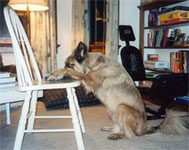
Select a chair in the house for your dog to use, one heavy enough
so it will not slide when the dog leans against it, and just high
enough for your dog to rest its forepaws on it comfortably. Take
your dog to the chair and sit the dog in front of the chair. Give
the command, "Say your prayers." As you do this, lift its front
feet and place them on the edge of the chair, and gently lower its
chin until the chin is resting on the dog's paws. Soothe your dog
with kind words as you do this, hold the dog in position a few
moments, then release with much praise. As with all other tricks,
it is simply a matter of repetition until the dog gets the idea and
performs the trick on its own. One difficulty is placement of the
head. Holding the head in a certain position is something quite
foreign to dogs, and it may take many repetitions before the dog
understands this particular part. Keep at it with patience and
praise until your dog catches on. Obedience training in the "stay"
is helpful here.
 Bring the newspaper
Bring the newspaper
Here tricks come into the area of usefulness because it is handy to
have your dog bring the evening newspaper, your shoes, or whatever
you happen to want but are too lazy or tired to get up and get
yourself. Once your dog has learned the basics of getting and
bringing to you any one thing, it can be taught to recognize the
word for, and bring you, any number of items.
First the dog must learn the simple retrieve. Without going into the regular obedience retrieve you can get the idea across to your dog by simply playing ball. Throw a ball and let your dog bring it back to you in play. Go on from this to throwing a stick, a rolled-up newspaper, a glove, or any item small enough for your dog to carry but large enough it won't swallow it.
When the dog is carrying things happily for you, give your dog a newspaper to carry. Give it the command, "Bring the paper" or "Fetch the paper" and encourage your dog to bring it to you. At first, you'll need to go outside with the dog to encourage it to pick up the paper and bring it in. Take the paper from the dog when it gets inside. Then give the dog lots of praise and a treat. After about 10 days or so, the dog will be getting the idea and you can stand at the door and tell it to get the paper. Whenever the dog does go out and brings back the paper, be sure to praise a lot. Note: if your dog is likely to run away when off lead, do not try this trick.
When you want your dog to bring anything other than the paper, you'll have to work with the dog on each item. It won't take as long to teach, but you must be patient. At first the dog will be confused so be sure to praise. If you tell the dog "no" and act angry, it will think you're upset because it brought you something. The dog won't understand that it brought the wrong thing.
Crawl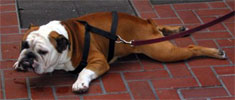
To teach your dog to crawl, you need a chunk of its favorite food.
Tell the dog to lie down. Place your left hand over but not
touching his back. Hold the food in your right hand, out a foot or
two in front of its face. Tell your dog "Crawl" and start moving
the food away. If the dog starts to stand up, gently help it back
down with your left hand and command "Crawl" again. Repeat several
times a day. When the dog actually crawls, even two or three steps,
give it the treat. Eventually it will get the idea that it must
crawl a little way before it gets a treat.
All these tricks are easier to teach if your dog is obedience trained. How's that for a sales pitch for obedience!
You can take pictures of your dog doing
tricks and make a photo book with us.
Make custom photo books of your dogs amazing tricks
to show off to your friends.
Undecided then please take a look at our photo book samples to get an idea.
Author: Cheryl May (news1@k-state.edu)
article url: http://www-personal.ksu.edu/~may/text6.html



